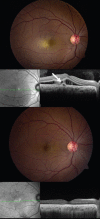Management of Retinal Diseases in Pregnant Patients
- PMID: 29403592
- PMCID: PMC5782459
- DOI: 10.4103/jovr.jovr_195_17
Management of Retinal Diseases in Pregnant Patients
Abstract
Pregnancy leads to significant changes in the body, which potentially affect the retina. Pregnancy can induce disease, such as that seen in hypertensive retinopathy and choroidopathy. It can cause exudative retinal detachments in the HELLP syndrome (hemolysis, elevated liver enzymes and low platelets), disseminated intravascular coagulation (DIC), and thrombotic thrombocytopenic purpura (TTP), and provoke arterial and venous retinal occlusive disease. Pregnancy may also exacerbate pre-existing retinal disease, such as idiopathic central serous chorioretinopathy (ICSC) and diabetic retinopathy. Special consideration needs to be exercised when treating pregnant patients in choosing medications, as well as in selecting diagnostic modalities and surgical methods.
Keywords: Exudative Retinal Detachment; Pregnancy; Retina.
Conflict of interest statement
There are no conflicts of interest.
Figures




References
-
- Petraglia F, D’Antona D. Maternal adaptations to pregnancy: Endocrine and metabolic changes. UpToDate, 2017. Available from: www.uptodate.com/contents .
-
- Foley MR. Maternal adaptations to pregnancy: Cardiovascular and hemodynamic changes. UpToDate, 2017. Available from: www.uptodate.com/contents .
-
- Sheth BP, Mieler WF. Ocular complications of pregnancy. Curr Opin Ophthalmol. 2001;12:455–463. - PubMed
-
- Blodi BA JM, Gass JDM, Fine SL, Joffe LM. Purtscher’s-like retinopathy after childbirth. Ophthalmology. 1990;97:1654–1659. - PubMed
-
- Errera MH, Kohly RP, da Cruz L. Pregnancy-associated retinal diseases and their management. Surv Ophthalmol. 2013;58:127–142. - PubMed
Publication types
LinkOut - more resources
Full Text Sources
Other Literature Sources

